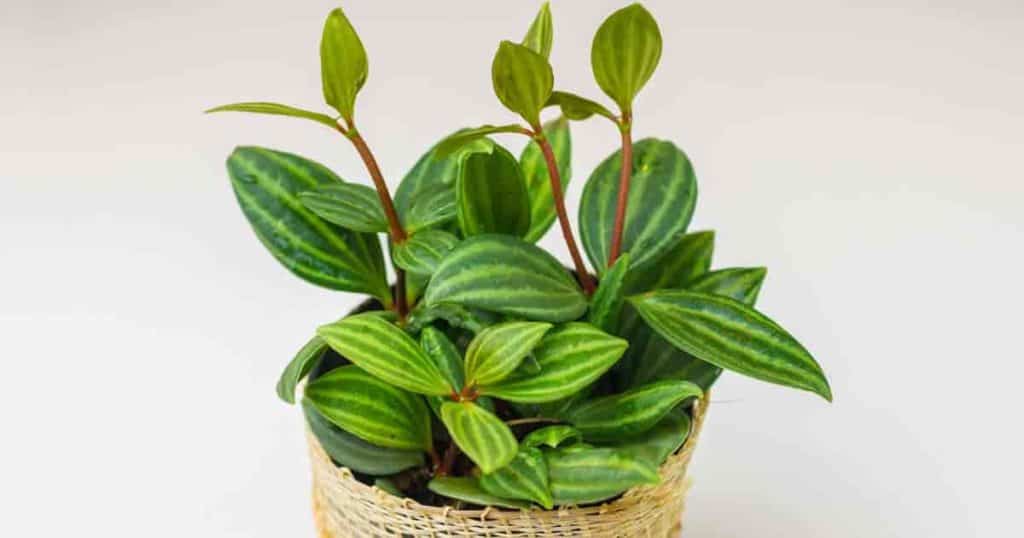Peperomia puteolata [pep-er-ROH-mee-uh, pu-tee-oh-LAY-tuh] is a perennial forest dweller hailing from South America.
The Peperomia puteolata plant is a member of the pepper or Piperaceae family which is made up of over a thousand peperomia varieties of both subtropical and tropical plants.

You may hear of this groundcover referred to by its common names:
- Parallel Peperomia
- Chinese Money Plant
- Radiator Plant
Its compact size and attractive, colorful leaves make it a popular houseplant.
Peperomia Puteolata Care
Size & Growth Habit
These delicate, trailing plants produce cascading stems approximately 16” inches long, but they grow longer under ideal circumstances.
The compact size and good looks make Peperomia puteolata an excellent choice as a hanging basket specimen or as a tabletop plant.

Like its cousin the Peperomia watermelon, this plant has leaves with attractive patterns reminiscent of the stripes found on watermelon rinds.
The oval leaves grow in whorls around the plant stems.
The colorful foliage is patterned in dark green and white, and the stems are a deep maroon or reddish color.
Flowering & Fragrance
In the springtime, a healthy and happy parallel Peperomia puteolata may send out flower spike inflorescence with very small and nondescript white flowers.

The flowers are not the main attraction for this plant.
Like other members of its family, it’s most admired for its attractive leaves.
Light & Temperature
Keep Peperomia puteolata in bright indirect sunlight. Direct sunlight will cause scorching on the leaves.
A lack of bright light will cause stunted growth.
Keep this tropical plant at a consistent temperature of 65° – 75° degrees Fahrenheit (18° C – 24° C).

Never allow the temperature to drop below 50° degrees Fahrenheit (10° C).
Protect Peperomia puteolata from hot or cold drafts and sudden changes in temperature.
Watering & Feeding
These semi-succulent plants have the same watering requirements as full succulents.
Wait until the soil is nearly dry and then provide a deep watering.
If you wait a bit too long, you may find your Peperomia has wilted leaves.
A good deep watering will resolve this problem.
Never overwater or allow your plant to stand in water as this will lead to root rot.
Keep the humidity level consistent by protecting your plants from cold or hot drafts (as from opening and closing doors and heating vents).

Grouping plants together can help stabilize humidity levels.
Mist occasionally during very dry weather.
During the growing season, spring and summer, fertilize every couple of weeks with a light solution of liquid houseplant fertilizer.
Half strength is usually enough.
At summer’s end, stop feeding and do not resume until spring.
Soil & Transplanting
Use a well-draining, soilless potting mix consisting of one part perlite and two parts peat moss.
The idea is to have a mixture capable of retaining a moderate amount of water while still providing excellent drainage.

Frequent repotting is not necessary.
Wait until your plant begins to outgrow its pot and then move it up to the next size.
The roots of Peperomia puteolata are fairly small, so it does well when planted in a shallow pot.
Grooming & Maintenance
The low requirements of Peperomia plant care make them a good option for beginners.
Its needs are simple and easy to provide.
Consistent moderate temperatures, bright but indirect light, an occasional deep watering will keep this very attractive plant happy and healthy.
As Peperomia puteolata matures, pinch out the stems to control the plant’s size and maintain an attractive shape.
You may need to prune occasionally.
Parallel peperomia plants should be pruned anywhere along the stem.
When you do, remember to keep cuttings to propagate more plants.
Propagating Peperomia Plants
Parallel Peperomia has leaves less succulent and a bit smaller than other members of its family.

Although it’s possible to propagate this plant with either stem or leaf cuttings, the small size of the leaves makes stem tip cuttings more successful.
- Trim off an inch or two of the stem tip.
- Be sure your cutting has a minimum of one node and a couple of leaves.
- Place the cutting on a piece of paper towel and in a warm, airy, dimly lit setting for twenty-four hours.
- This will allow the cut to dry and heal.
- Place the cutting in a small pot of moist planting mixture as described above.
- It’s helpful to dip the end of the cutting in rooting hormone first.
- Place a plastic bag loosely over the cutting and set the pot in a setting suitable for maintaining Peperomia health.
- New plants will start growing from the leaf base.
- It should be consistently warm at about 68° degrees Fahrenheit (20° C), still with ample bright, indirect sunlight.
You should see new growth within a couple of weeks.
Learn on about: How To Propagate Peperomia
Peperomia Pests or Diseases
The main problem for Peperomia puteolata and all of its family members is overwatering.
Plants over watered and or fertilized excessively are subject to root rot and pest infestation.

Plants not growing well may be in need of more light.
Mealybugs may occasionally be problematic on Peperomia plants but are easily controlled with a good wash and spot treatment with rubbing alcohol on a cotton swab.
Learn more about mealybug treatment.
Is Peperomia Toxic Or Poisonous?
Peperomia is an excellent plant for kids and pets because it is completely non-toxic. That does not mean pets cannot get sick.
Is Peperomia Invasive?
This tropical houseplant is not invasive in the United States of America.
Suggested Uses for Parallel Peperomia
Parallel Peperomia is a moderate-sized, versatile house plant grown easily in a greenhouse, conservatory, on a kitchen window sill or as plants for bathrooms.

Their elegant look and upward growth habit make for great container indoor plants.
It is also a good candidate as a terrarium plant, in a dish garden or a hanging basket.
